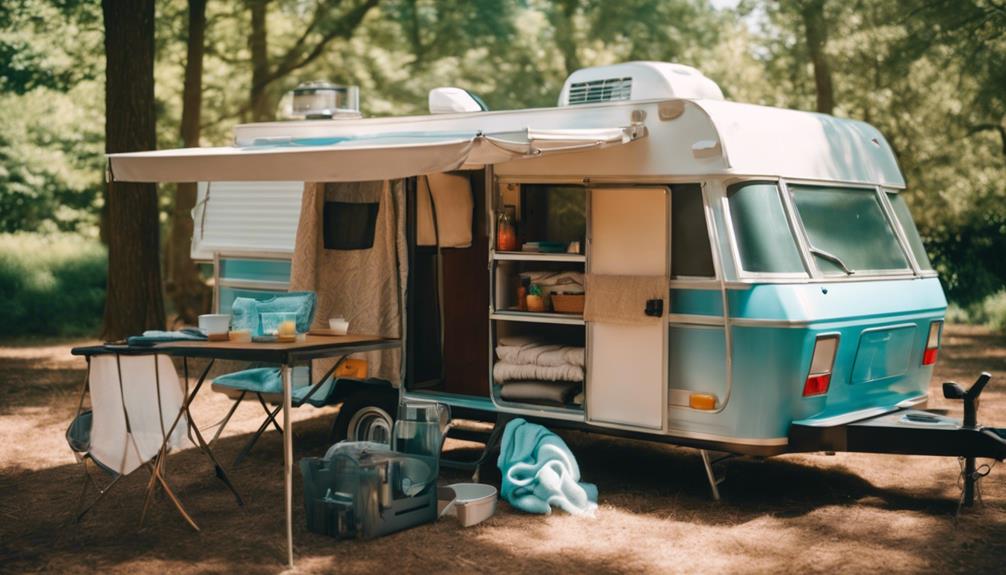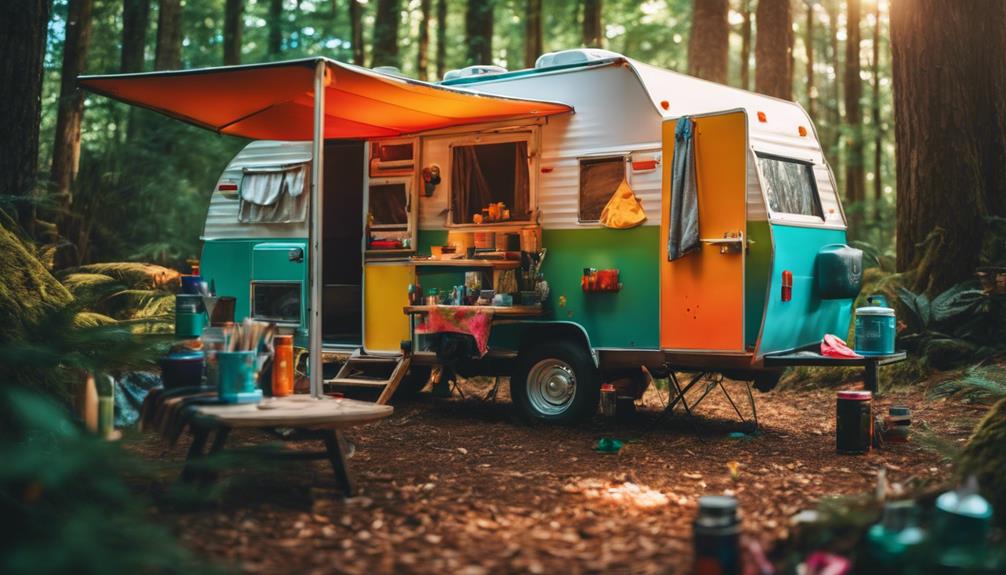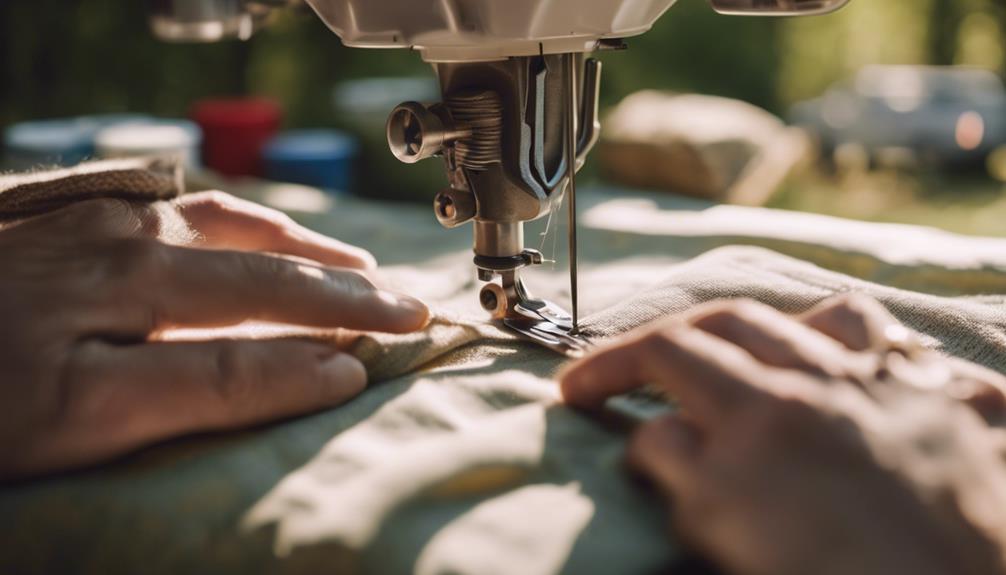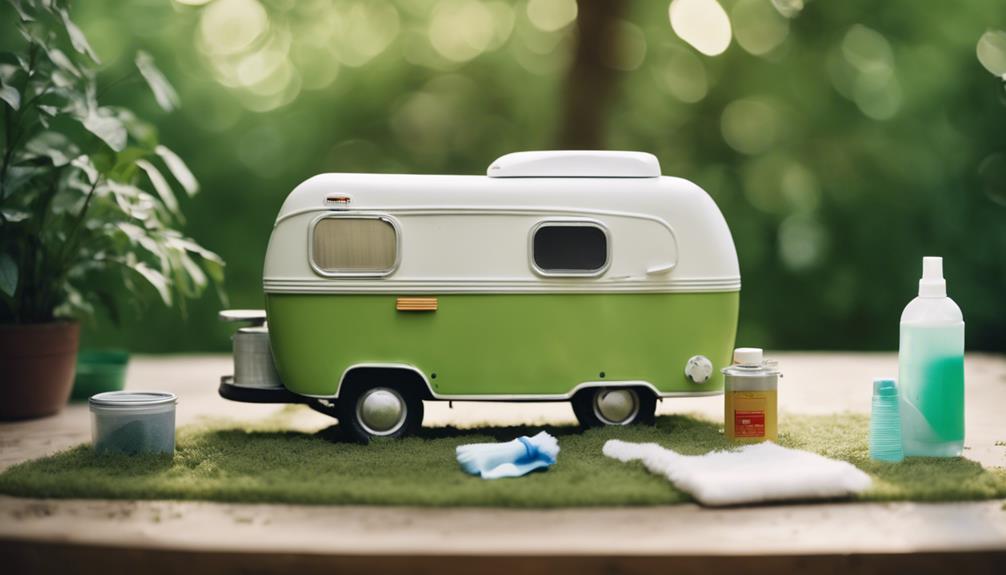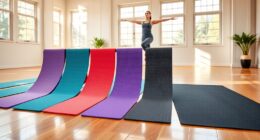To dry out your pop-up camper and prevent mold and mildew, start by ensuring it's completely dry before storing. Open windows and vents for airflow, and use dehumidifiers to remove excess moisture. After each trip, inspect folds and seams for trapped dampness. Store the camper in a well-ventilated area, ideally indoors, to avoid leaks and humidity build-up. Regularly clean all surfaces and use moisture absorbers like DampRid to maintain a dry environment. Make it a habit to check for leaks and air out your camper occasionally. Keep going to discover even more effective techniques and tips.
Key Takeaways
- Ensure the camper is completely dry before storage by checking folds and seams for trapped moisture.
- Store the camper in a dry, well-ventilated area to prevent moisture accumulation and mold growth.
- Use dehumidifiers and moisture absorbers like DampRid to maintain a drier environment inside the camper.
- Conduct regular inspections for leaks and signs of moisture, especially after heavy rain or during seasonal changes.
Understanding Mold and Mildew
Mold and mildew thrive in the warm, humid environment of your pop-up camper if you don't manage moisture and airflow effectively. These fungi can spread quickly in closed spaces, making it essential to understand the conditions that favor their growth. High humidity levels, often caused by poor air circulation, create an ideal breeding ground for mold and mildew.
To prevent these issues, you should implement effective preventive strategies. Start by regularly inspecting your camper for potential growth areas, such as corners, under cushions, and around windows. Cleaning these spots frequently helps eliminate existing spores and moisture.
Enhancing air circulation is another important step; open windows and vents to allow fresh air in, especially after using your camper. You might also consider using dehumidifiers to reduce humidity levels.
Storage and Dryness Practices
To keep your pop-up camper in top shape, store it in a dry, well-ventilated area.
Make certain it's completely dry before closing it up to avoid mildew, and don't forget to check for leaks regularly.
Following these simple practices will help guarantee your camper remains moisture-free and ready for your next adventure.
Optimal Storage Location
Choosing the right storage location for your pop-up camper is essential to keep moisture at bay and protect it from potential damage. You should aim for a dry, well-ventilated area to prevent moisture accumulation, which can lead to mold growth and mildew. Here's a quick reference table to help you choose the ideal storage location:
| Storage Option | Benefits |
|---|---|
| Indoor Garage | Controlled environment, no leaks |
| Outdoor Canopy | Protection from rain, promotes airflow |
| Shed or Barn | Keeps camper dry, reduces sun exposure |
| Sloped Driveway | Prevents water pooling, enhances drainage |
| Covered Lot | Shields from elements, easy access |
Make certain to use a protective cover when storing your camper outdoors. This helps shield it from direct rain and moisture exposure. Regularly check for leaks around seams and folds to maintain a moisture-free environment. Additionally, storing your camper at a slight incline can further reduce the likelihood of moisture buildup. By taking these steps, you'll guarantee effective mildew prevention and keep your pop-up camper in great shape for your next adventure.
Ensure Complete Dryness
Making certain your pop-up camper is completely dry before folding it up is essential for preventing moisture-related issues like mold and mildew. After every trip, take the time to check for any accumulated moisture, especially in folds and seams. If you find any damp areas, make certain to dry them out thoroughly before storage.
When it comes to storage, choose a well-ventilated area or set up a patio tent to shield your camper from direct rain. This will help keep moisture at bay. Additionally, it's a good idea to store your camper at a slight incline. This simple adjustment allows water runoff, preventing pooling of moisture that could lead to unwanted mold growth.
Don't forget to occasionally unfold your camper and expose it to direct sunlight. Sunlight is a natural enemy to mold spores, helping to dry out any trapped moisture.
Regular Leak Inspections
Regularly inspecting your pop-up camper for leaks is crucial to preventing moisture buildup and avoiding mold growth. Focus on seams, zippers, and areas around windows and vents during these regular inspections. If you detect any leaks, fix them promptly to minimize moisture accumulation.
To help you stay vigilant, here's a quick reference table for identifying potential issues:
| Signs of Moisture | Possible Source | Action Required |
|---|---|---|
| Musty odors | Hidden leaks | Conduct thorough inspections |
| Discoloration | Water intrusion | Repair damaged areas |
| Dampness in fabric | Poor ventilation | Improve airflow |
| Water stains | Roof or window leaks | Seal and repair |
Perform seasonal checks, especially after heavy rain or during winter storage, to catch any potential leaks before they lead to significant mold growth. Store your camper in a dry environment and confirm it's completely dry before closing it up. By being proactive and addressing any signs of moisture early, you can effectively prevent mold and maintain your camper in great condition.
Dehumidification Techniques
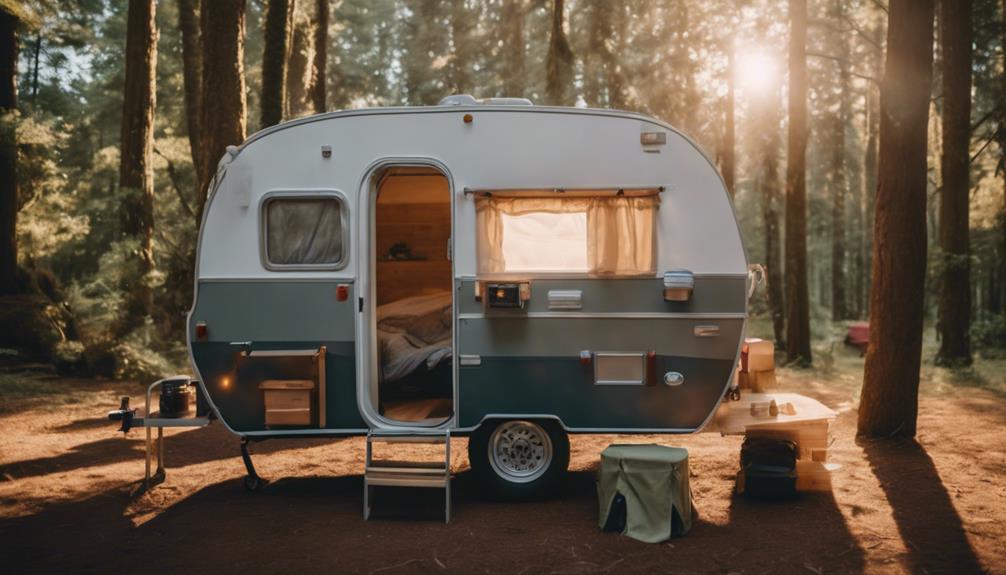
To effectively combat moisture in your pop-up camper, employ various dehumidification techniques that can greatly improve air quality and prevent mold growth. Here are three essential methods to take into account:
- Use Dehumidifiers: Place dehumidifiers in strategic locations, especially in areas prone to moisture like kitchens and bathrooms. They continuously reduce humidity levels, helping to combat excess moisture effectively.
- Incorporate Moisture Absorbers: Utilize products like Damp-Rid or Dri-Eze to absorb excess moisture during storage. These are specifically designed for enclosed spaces, so replace them regularly for ideal effectiveness. You can also use natural moisture absorbers such as activated charcoal or rock salt in open containers to maintain a drier environment.
- Air Out Your Camper: Regularly set up your camper in dry weather, opening windows and vents to promote airflow. This helps lower humidity levels and keeps your camper fresh.
Cleaning and Maintenance Tips
To keep your pop-up camper in top shape, you need a regular cleaning routine that targets all surfaces, especially after trips.
Moisture control solutions like dehumidifiers can help prevent mold and mildew during storage.
Regular Cleaning Routine
A thorough cleaning after each camping trip helps keep your pop-up camper free from dirt, dust, and food residues that can lead to mildew growth.
Regular cleaning is essential for preventing mold and ensuring a pleasant camping experience.
Here are three essential steps to maintain a clean camper:
- Inspect and Dry: After each trip, check all surfaces for moisture accumulation, especially in seams and folds. Promptly dry any damp areas to inhibit mold development.
- Gentle Cleaning: Use a soft brush or vacuum to remove debris from canvas and vinyl surfaces. Follow up with a wash using mild soap and water, focusing on both the interior and exterior. This light cleaning routine in spring will eliminate lingering spores.
- Moisture Control: During storage, regularly replace moisture-absorbing products like DampRid to maintain a dry environment. This will minimize the risk of mold while keeping your camper fresh.
Moisture Control Solutions
Maintaining moisture control inside your pop-up camper is vital for preventing mold and guaranteeing a clean, comfortable space for your next adventure.
Start by using moisture-absorbing agents like DampRid to create a drier environment. It's essential to regularly clean and dry the camper's interior after each use, focusing particularly on the canvas upholstery and other surfaces to confirm they're moisture-free before storage.
Inspect your camper for leaks, and repair any areas where moisture accumulates promptly. This will minimize the risk of mold and mildew developing within the camper.
During storage, set up the camper periodically to promote airflow and allow it to dry out naturally, especially after rainy weather.
Additionally, using portable heaters or fans can greatly expedite drying by increasing air circulation and reducing humidity levels inside the camper.
Airflow Management Strategies
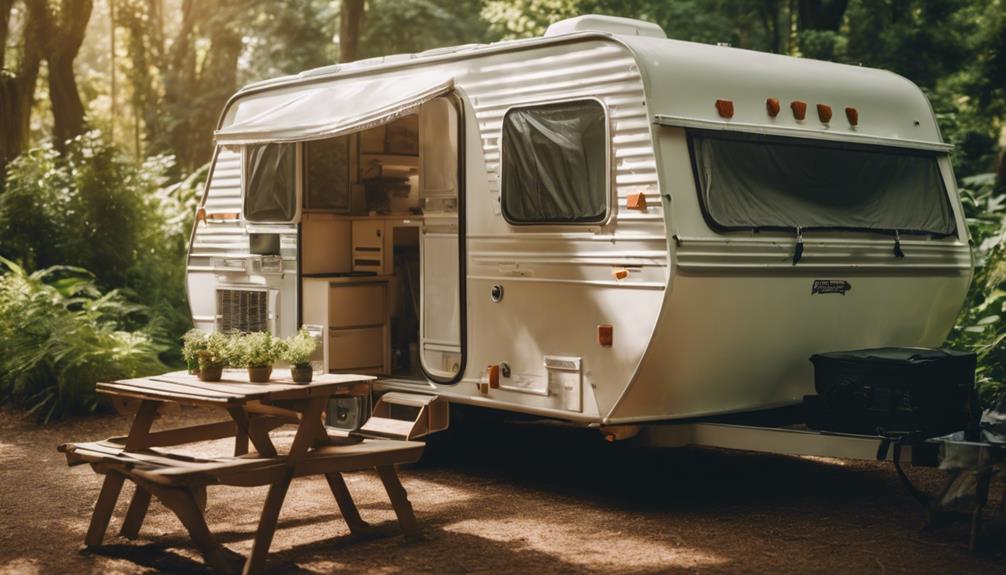
Effective airflow management is crucial for keeping your pop-up camper dry and free from mold. By improving ventilation, you can greatly reduce humidity and moisture levels inside. Here are three strategies to enhance airflow:
- Open Windows and Vents: Always keep windows and vents open during and after use. This promotes airflow and reduces humidity, allowing moisture to escape.
- Use Fans: Utilize fans to circulate air effectively, especially after rain or when your camper is closed for extended periods. Fans help to keep the air moving, preventing stagnant conditions that can lead to mildew.
- Organize Storage: Make sure items stored inside don't block air pathways. This allows for better circulation and moisture evaporation. Keep your belongings organized to maintain the best airflow.
Additionally, set up your camper in a well-ventilated area during storage. Regularly airing out the camper by fully extending it in dry weather can also minimize the risk of mold and mildew growth.
Community Insights and Resources
Community engagement thrives among pop-up camper owners, who enthusiastically share insights and resources for drying out campers and preventing mold. Online forums like PopUpPortal are buzzing with community discussions that focus on moisture management and best practices. You'll find many effective products highlighted, including DampRid and natural options like tea tree oil, which many users swear by.
Here's a quick comparison of popular moisture management products and methods:
| Product/Method | Description |
|---|---|
| DampRid | Moisture-absorbing crystals; great for air circulation. |
| Tea Tree Oil | Natural cleaning agent with mold prevention properties. |
| Fans | Improves air circulation; reduces humidity. |
| Dehumidifiers | Removes excess moisture; highly effective in closed spaces. |
Seasonal Mold Prevention Steps
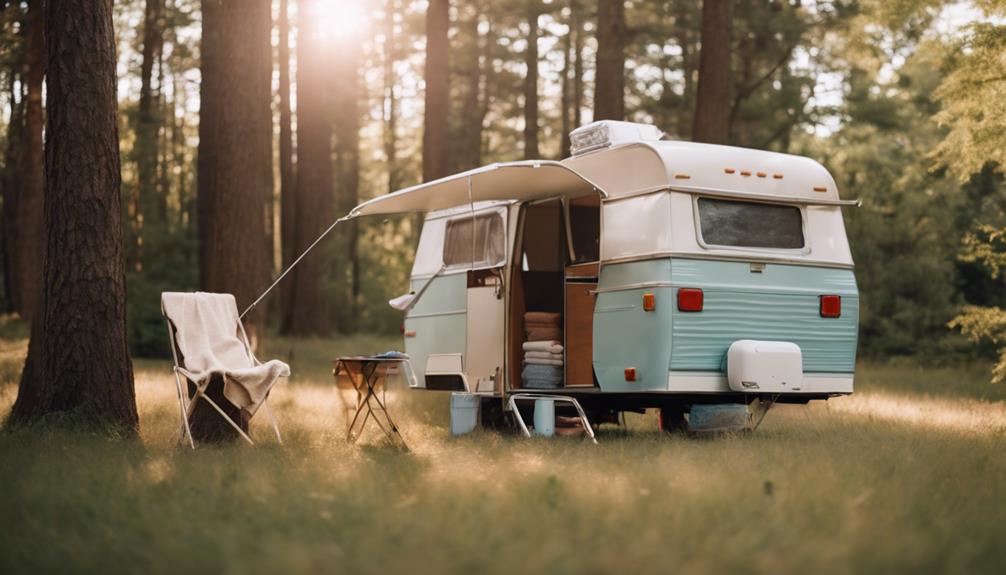
To keep mold at bay, you should dry your pop-up camper thoroughly after every use and inspect it regularly for any signs of moisture. Mold growth can flourish in hidden folds and seams if moisture accumulation isn't addressed.
To guarantee effective mildew prevention, follow these seasonal steps:
- Conduct Seasonal Inspections: Check your camper, especially in spring and fall, to spot any leaks or moisture. Early detection is key to preventing mold growth.
- Utilize Dehumidifiers: When storing your pop-up camper, employ dehumidifiers and moisture-absorbing products like DampRid to maintain a dry environment. This is vital for combating potential mold issues during off-seasons.
- Promote Airflow: Store your camper in a well-ventilated area. Occasionally setting it up allows for better airflow, facilitating drying and reducing humidity. Additionally, treat the canvas and other surfaces with mold-resistant solutions for extra protection.
Frequently Asked Questions
How to Keep Moisture Out of a Pop-Up Camper?
To keep moisture out of your pop-up camper, store it in a dry, ventilated area, use moisture absorbers, regularly inspect for leaks, and set it up occasionally to air it out. Don't neglect these steps!
How to Dry a Pop-Up Tent?
To dry a pop-up tent, unfold it in sunlight, ensuring all areas get airflow. Brush off dirt, check seams for moisture, and use moisture-absorbing products to help eliminate humidity and prevent future issues.
How Do I Keep Moisture Out of My Camper in Storage?
Imagine a damp sponge versus a sun-dried towel; keep your camper dry by using dehumidifiers, breathable covers, and storing it in a ventilated area. Regularly check for leaks, tackling moisture issues immediately to prevent mold.
How Do You Get Mildew Out of a Pop-Up Camper?
To get mildew out of your pop-up camper, clean affected areas with a vinegar solution, use stiff brushes, and wipe moisture away. Guarantee thorough drying by exposing it to sunlight and fixing any leaks promptly.
What are the best methods for preventing mold and mildew in a pop-up camper while drying it out?
The best methods for preventing condensation in camper while drying it out include using moisture-absorbing products like silica gel packs or dehumidifiers. Proper ventilation is also crucial, so make sure to keep windows and vents open. Regular cleaning and maintenance to remove any mold or mildew is essential for preventing future growth.
Conclusion
By taking these steps to dry out your pop-up camper, you're not just protecting your investment; you're ensuring it stays a cozy retreat for your adventures.
Think of it as giving your camper a rejuvenating spa day, free from the worries of mold and mildew.
With a little attention and care, you can keep your camping haven in tip-top shape, ready to welcome you with open arms whenever you hit the road again.

